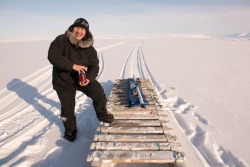Most northern employee monitors ice for safe travel

Andrew Arreak is doing his utmost to keep the Inuit community of Pond Inlet safe.
As the local research co-ordinator for SmartICE (Sea-ice Monitoring and Real-Time Information for Coastal Environments), Mr. Arreak is combining traditional ice knowledge with the latest technology in satellite tracking and ice sensing equipment to map ice conditions in the Qikiqtaaluk Region of Nunavut.
And the lucky guy gets to be out on the sea ice for much of his time to do so.
‘Main highway’
“The sea ice is our main highway and we travel on it to hunt, harvest and get to family camping areas,” says Mr. Arreak, the father of five young children, including twins that were born in September. “In community meetings we identified sea-ice conditions as top of our list for prioritized research. That’s how I came to work for SmartICE.”
The project, currently funded for three years, is primarily directed by the community itself. Mr. Arreak responds to feedback from friends and neighbours as to what areas of the ice he should deploy the SmartQuamutik, the large sensor he drags behind his snowmobile that measures ice thickness using electromagnetic fields.
“This gives them an idea of how long they can be out on the ice and return home safely. We combine our own traditional ability to read ice conditions with technology to get more accurate information.”
The collected data is loaded onto a server, which produces user-friendly maps depicting ice thickness and reliability using a colour-coded system. Green ice is safe for travel and “no go” areas appear in red and orange. Mr. Arreak distributes maps to individuals and posts them in community gathering places.
Community driven
Climate change has greatly affected the yearly freeze-up of the bays and inlets that make up much of this region on northern Baffin Island, just 1,190 miles from the North Pole.
Community-driven projects such as SmartICE can make a huge amount of difference to a community like Pond Inlet, empowering individuals such as Mr. Arreak and his fellow Inuit to continue to live in traditional environments while partnering with researchers. SmartICE is currently being piloted in Nain, Labrador, as well.
SmartICE project leader, Dr. Trevor Bell, Department of Geography, Faculty of Humanities and Social Sciences, hired Mr. Arreak for the position.
‘For other northern communities’
“Andrew is very proud to be a Memorial University employee,” said Dr. Bell. “He carries out his responsibilities with great care and devotion. He loves learning about the new technology, going out on the ice with the SmartQuamutik and reporting back to the community on the state of the ice.”
Currently in the second year of the three-year pilot, Mr. Arreak intends to continue in his role as research co-ordinator for as long as possible.
“The biggest challenge right now is finding more funding to make SmartICE a full-time service — not only for Pond Inlet, but for other northern communities, as well.”